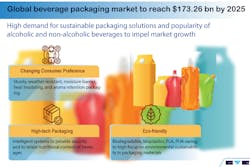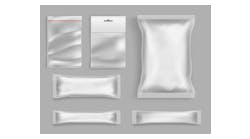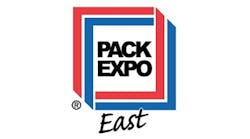4 mega trends that will change the beverage packaging market
The beverage packaging market is undergoing several changes that are anticipated to transform the face of the market. Beverage packaging aids in providing product support, tampering resistance and external environmental protection to the beverage. It also assists in the reliable distribution of beverages through the various building blocks of the value chain. Intense market competition, along with growing demand from end-user industries, has driven packaging manufacturers to implement innovative growth strategies to maintain their market position.
Fluctuating demographic conditions and buying patterns are making it difficult for market leaders to capitalize on the market movements in the beverage packaging industry. Development of intelligent packaging systems that can interact with the product or its environment to improve the conservation of beverages (including beer, juices and wine), customer acceptability and food safety are some of the key trends in the global market.
Graphic courtesy of Grand View Research, www.grandviewresearch.com
Here are the four mega trends that will change the beverage packaging market over the coming years.
1. Automation of packaging process
Automation has spread its roots in almost every field today. Even in the case of beverage packaging, most processes are now automated. Some believe the day is not so far off when this industry will be 100 percent automated without any human intervention. Processes such as depalletizing, secondary, primary and tertiary packaging and unpacking have already witnessed automation at a large scale, with human intervention being replaced by machines that can finish the task with a few taps on the screen.
Let’s consider an example of automation in quality control (QC) inspection. The bottle-filling process involves inspection of the material to be filled in, and the inspection of the bottle post-filling. In the past, workers used to lift up the bottle from the assembly line, inspect it and then release it. With an automated process, bottles can be inspected online as they are getting filled. This shift toward automation will result in unemployment to a certain extent, but it also results in the requirement of skilled labor to operate the machines.
2. Acquisitions of small vendors by conglomerates
Several global players are getting bigger by acquiring smaller and specialized vendors. These conglomerates have the skilled labor and latest technology and machinery to manufacture quality products under one umbrella. This trend results in a one-stop-shop solution for companies across the beverage industry value chain. So, how does this impact food and beverage processors? Suppose a company is engaged in building or renovating a facility, a larger one-stop-shop will accelerate the project.
Consider an example wherein a beverage producer needs a set of bottles for its processing plant. An integrated company would have the necessary equipment and technical manpower to deliver the product in a shorter timelines —even within half of the time.
In 2009, Coca-Cola launched THE world’s first PET bottle, PlantBottle made from renewable materials. This bottle is manufactured using patented technology that uses sugarcane and waste from the sugarcane manufacturing process. Since the launch, the company has distributed more than 35 billion PlantBottles across 40 countries. The company claims to have reduced carbon dioxide emissions by 315,000 tons using these bottles.
Such initiatives will not only help to reduce carbon footprint and help a company to establish as an eco-friendly brand, but also ensure timely deliveries of its products.
3. Shift toward eco-friendly packaging
Bioplasticsare an alternative to conventional plastics that are particularly suitable in the beverage packaging industry because they are completely or partially biobased and are therefore biodegradable to some degree. Bioplastics are materials in which all the carbon is derived from various renewable natural sources including sugarcane, potatoes, seashells, corn, starchand bacteria.
According to a new report by Grand View Research Inc., the global beverage packaging market size was estimated at $117 billion in 2016. One of the key drivers for growth is the increased emphasis on environmental sustainability, which is likely to result in lower consumption of petroleum-based products and a growing demand for biobased alternatives. Bioplastics including PHA and PLAare biodegradable, whereas bio-PETand bio-PE are not biodegradable. However, because they all are biosourced they get broken down faster as compared to petroleum-based plastics. Bioplastics are preferred over conventional plastics as they provide a lower carbon footprint.
Carbon footprint is a major concern associated with the manufacturing of plastics via crude oil. The consumption of bioplastics is expected to substantially reduce the carbon footprint in the industry and therefore it is being encouraged by major regulatory bodies around the world. European researchers at AINIA Technology Center in Spain have developed a new version of a prototype designed for bioplastic juice packaging. After four years of extensive research and development, the result is PHBOTTLE, which is made up of organic matter created from waste byproducts of juice processing. The matter is rich in fermentable glucose, sugar, maltose and fructose.
In 2016, Bio-on, an Italian biotech firm, created biodegradable containers made up of bioplastic and paper in collaboration with Tampere University of Technology, Finland. The containers are recyclable and are safe for food and beverage and medical applications. They are made up of polyhydroxyalkanoate (PHA), which is a 100 percent biodegradable bioplastic made of waste materials derived from agricultural processing.
4. Product innovation to develop sustainable packaging solutions
The key features of beverage packaging include prevention of product damage, wastage and deterioration. This aids in increasing the transportation efficiency of goods, making supply chain management more effective, enabling safer delivery of goods and serving as a tool for product identification and branding purposes. Changing customer preferences have led to the enhancement of packaging materials with properties such as enhanced strength, heat insulation, aroma retention and barrier against moisture. Rising demand for small packs has given impetus to the flexible bag and pouch segment.
Introduction of active and intelligent packaging systems in beverage packaging has also contributed significantly to market growth. The beverage packaging industry is accepting intelligent systems at a rapid pace to achieve maximum security and maintain the nutritional content of beverages. Active packaging results in extended shelf life of a product by employing several systems such as oxygen scavengers, moisture absorbers, antimicrobial agents and antioxidants.
Rapid growth in the e-commerce industry will drive the change and adaptation of packaging. This also provides a great opportunity for market players to develop packaging solutions that can add value for customers.
Snehit Borse is a team lead at Grand View Research Inc.(chemicals and materials) with overall experience of five years in market research, business intelligence, consulting and strategy building. Borse’s primary focus is on assessing new market opportunities and market sizing, identifying and evaluating complex value chains across the globe. He has expertise in various industries that include packaging, polymers, petrochemicals, specialty chemicals, ceramics, and composites. Borse holds a master’s degree in marketing management from the University of Pune in India.




